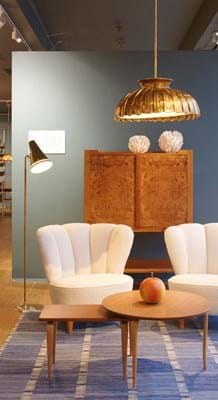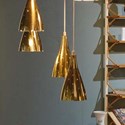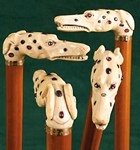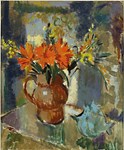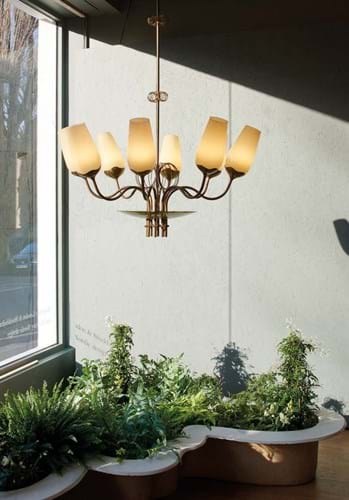
One of the stand-out pieces in the Modernity Paavo Tynell exhibition is this monumental chandelier in brass and opaline glass, designed for a private residence in Mikkeli Finland in 1949. Featuring small decorative flowers, one of Tynell’s signature design elements, it is offered for £60,000.
Photo: James Harris
Featuring its original fabric diffuser, the lamp stands out among works of this period for the use of brass, which would become the defining material in Tynell’s most celebrated works.
“It’s very rare because of its age and condition. It has all its original parts, despite being 90 years old”, says director Sebastien Holt, director of the Scandinavian design gallery in Notting Hill.
Paavo Tynell: The Man who Illuminated Finland opened in time to mark the lighting designer’s 132nd birthday on January 25 and runs until February 28. It puts the emphasis on the development of Tynell’s style, opening with a timeline of his life and displaying the 18 pieces in a more-orless chronological trail spanning the 1930s-50s.
The 1930s lamp is offered for £46,000, putting it in the midrange for prices at the show. The top price is £69,000 for a brass 1950s ceiling lamp, though this is still far less than Tynell’s design can make. Since the mid-2010s, prices have regularly stretched into six figures on the open market, with the current record of more than £250,000 set at Artcurial in 2020 (source: Artprice by Artmarket).
Industrial production
Tynell became a sheet metal apprentice with GW Sohlbergs at the age of 16, and went on to co-found the company Taito Oy, the first industrial producer of lighting fixtures in Finland. He worked as the company’s CEO and chief designer until 1953.
Holt says: “He was in full creative control of lighting at Taito Oy and as he progressed he became more confident in his design. He started creating works with these pierced holes.”
At the same time, he moved from a functionalist aesthetic to a more decorative style, influenced by organic forms. Typifying his later works is a 1950s ceiling light made of pierced brass and featuring small decorative flowers on its metal suspension. It is offered for £28,000.
Though the works on show are predominantly in brass, a collection of ‘Chinese hat’ lamps are also available. First designed during the 1940s at a time of rationing, the pieces are comprised of repurposed slatted wood and rattan shades.
Each lamp is displayed in a room set to give visitors an idea of how Tynell’s lighting could work in a comfortable contemporary home. Often they are displayed with furniture by the designer’s peers, such as his long-time collaborator Alvar Aalto.
Layout is important since most of the gallery’s business comes from passing trade, thanks to its roomy corner space on Westbourne Grove, which opened last August.
Holt says: “We’ve tried to create a room that you could move right into. These are quite cosy. Each one is a sort of vignette of 20th century life.”
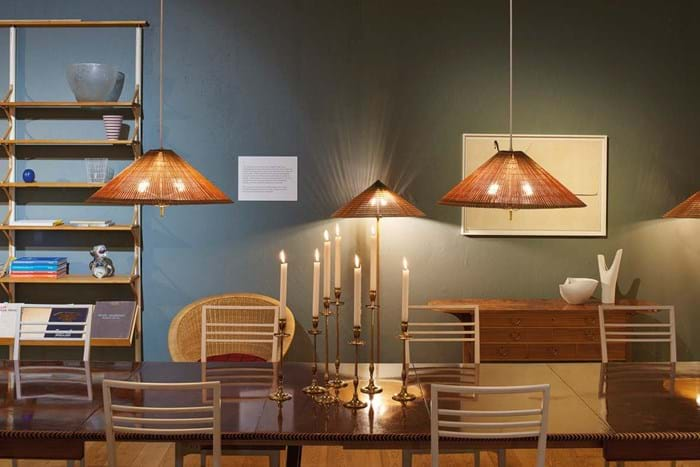
Ceiling lamp model A1967 designed by Tynell for Taito Oy, Finland, 1940s, brass, glass and slatted wood shade, £21,000 each; and one of a pair of floor lamps, model 9602, designed for Taito Oy, 1950s, brass and slatted wood shade, £69,000 for the pair at the Modernity exhibition.
Photos: James Harris
Modernity was launched in Sweden in 1998, where it remains in Östermalm, Stockholm’s design district. In September 2019 it opened its first London branch in Cavendish Square to “test the market”, according to Holt. Satisfied with its performance, the business took on a permanent lease, this time in the more relaxed, yet still monied, Notting Hill area.
Though Modernity makes frequent appearances at fairs, this year the focus is on the new gallery.


